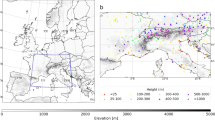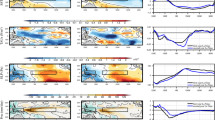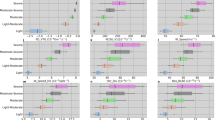Abstract
The contributions of synoptic- and meso-scales to the boundary layer wind profile evolution in a coastal environment are examined. The analysis is based on observations of the wind profile within the first 200 m of the atmosphere continuously recorded during a 10 year period (2001–2010) at the 213-m meteorological tower at the Cabauw Experimental Site for Atmospheric Research (CESAR, The Netherlands). The analysis is supported by a numerical experiment based on the Weather Research and Forecasting (WRF) model performed at high horizontal resolution of 2 km and spanning the complete observational period (10 years). Results indicate that WRF is able to reproduce the inter-annual wind variability but with a tendency to be too geostrophic. At seasonal scales, we find a differentiated behavior between Winter and Summer seasons with the Spring and Autumn transition periods more similar to the Summer and Winter modes, respectively. The winter momentum budget shows a weak intradiurnal variability. The synoptic scale controls the shape of the near surface wind profile that is characterized by weaker and more ageostrophic winds near the surface than at higher altitudes within the planetary boundary layer (PBL) as a result of the frictional turning. In turn, during summer, mesoscale circulations associated with the differential heating of land and sea become important. As a result, the PBL winds show a stronger intradiurnal component that is characterized by an oscillation of the near surface winds around the geostrophic direction with the maximum departure in the afternoon. Although also driven by thermal land-sea differences, this mesoscale component is not associated with the classical concept of a sea-breeze front. It originates from the thermal expansion of the boundary layer over land and primarily differs from the sea-breeze in its propagation speed resulting in a wind rotation far ahead of any coastal front. We refer to it as the near-coast diurnal acceleration (NCDA). The contribution of the NCDA depends on the specific orientation of the coast (NE-SW at CESAR). Our findings stress the importance of evaluating and understanding the performance of mesoscale models with multi-year observational/simulated data sets in order to provide a statistically robust characterization of the limitations of surface layer and boundary-layer parameterizations and thus compensate for the scarceness of upper level wind observations.



















Similar content being viewed by others
References
Baas P, Bosveld FC, Klein Baltink H (2009) A climatology of nocturnal low-level jets at Cabauw. J Appl Meteorol Climatol 48:1627–1642
Bosveld FC, van Ulden A, Beljaars A (1999) A comparison of ECMWF re-analysis data with fluxes and profiles observed in cabauw. Tech. Rep. 8, ECMWF Re-Analysis (ERA) Project Report, ECMWF
Bosveld FC, Baas P, Holtslag A, Angevine WM, Bazile E, Brujn ED, Decau D, Edwards JM, Ek M, Larson VE, Malardel S, Pleim JE, Raschendorfer M, Svensson G (2014) The third GABLS intercomparison case for boundary layer model evaluation. part b: results and process understanding. Bound Layer Meteorol 152:157–187
Coelingh J, van Wijk AJM, Holtslag AAM (1998) Analysis of wind speed observations on the North Sea coast. J Wind Eng Ind Aerodyn 73:125–144
Crawford KC, Hudson HR (1973) The diurnal wind variation in the lowest 1500 ft in central Oklahoma: June 1966-May 1967. J Appl Meteorol 12:127–132
Dee DP, Uppala SM, Simmons AJ, Berrisford P, Poli P, Kobayashi S, Andrae U, Balmaseda MA, Balsamo G, Bauer P et al (2011) The ERA-Interim reanalysis: configuration and performance of the data assimilation system. Q J Roy Meteorol Soc 137:553–597
Drechsel S, Mayr GJ, Messner JW, Stauffer R (2012) Wind speeds at heights crucial for wind energy: measurements and verification of forecasts. J Appl Meteorol Climatol 51:1602–1617
Dudhia J (1989) Numerical study of convection observed during the winter monsoon experiment using a mesoscale two-dimensional model. J Atmos Sci 46:3077–3107
Dudhia J (1996) A multilayer soil temperature model for MM5. Preprints, Sixth PSU/NCAR Mesoscale Model Users’ Workshop, Boulder, CO 80307, pp 49–50
Holtslag AAM (1984) Estimates of diabatic wind speed profiles from near-surface weather observations. Bound Layer Meteorol 29:225–250
Hong SY, Lim JOJ (2006) The WRF single-moment 6-class microphysics scheme (WSM6). J Korean Meteorol Soc 42:129–151
Hong SY, Noh Y, Dudhia J (2006) A new vertical diffusion package with an explicit treatment of entrainment processes. Mon Wea Rev 134:2318–2341
Hurley P, Luhar A (2009) Modelling the meteorology at the Cabauw tower for 2005. Bound Layer Meteorol 132:43–57
Jiménez PA, González-Rouco JF, Montávez JP, Navarro J, García-Bustamante E, Valero F (2008) Surface wind regionalization in complex terrain. J Appl Meteorol Climatol 47:308–325
Jiménez PA, Dudhia J, Navarro J (2011a) On the surface wind speed probability density function over complex terrain. Geophys Res Lett 38(L22):803. doi:10.1029/2011GL049,669
Jiménez PA, Vilà-Guerau de Arellano J, González-Rouco JF, Navarro J, Montávez JP, García-Bustamante E, Dudhia J (2011b) The effect of heatwaves and drought on the surface wind circulations in the NE of the Iberian Peninsula during the summer of 2003. J Clim 24:5416–5422
Jiménez PA, Dudhia J, González-Rouco JF, Navarro J, Montávez JP, García-Bustamante E (2012) A revised scheme for the WRF surface layer formulation. Mon Wea Rev 140:898–918
Jiménez PA, González-Rouco J, Montávez J, Navarro J, García-Bustamante E, Dudhia J (2013) Analysis of the long-term surface wind variability over complex terrain using a high spatial resolution WRF simulation. Clim Dyn 40:1643–1656. doi:10.1007/s00,382-012-1326-z
Kain JS, Fritsch JM (1990) A one-dimensional entraining/detraining plume model and its application in convective parameterization. J Atmos Sci 47:2784–2802
Kain JS, Fritsch JM (1993) Convective parameterization for mesoscale models: the Kain-Fritcsh scheme. In: Emanuel KA, Raymond DJ (eds) The representation of cumulus convection in numerical models. Meteorological monographs, vol 24. American Meteorological Society, pp 165–190
Lange B, Larsen S, Hojstrup J, Barthelmie R (2004) The influence of thermal effects on the wind speed profile of the coastal marine boundary layer. Bound Layer Meteorol 112:587–617
Levi Y, Shilo E, Setter I (2011) Climatology of a summer coastal boundary layer with 1290-MHz wind profiler and a WRF simulation. J Appl Meteorol Climatol 50:1815–1826
Mass CF (1982) The topographically forced diurnal circulations of western Washington state and their influence on precipitation. Bull Am Met Soc 110:170–183
Mlawer EJ, Taubman SJ, Brown PD, Iacono MJ, Clough SA (1997) Radiative transfer for inhomogeneous atmospheres: RRTM, a validated correlated-k model for the longwave. J Geophys Res 102:16663–16682
Pena A, Gryning SE, Mann J (2010) On the length-scale of the wind profile. Q J Roy Meteorol Soc 136:2119–2131
Pielke RA (2002) Mesoscale meteorological modeling. Academic Press, Amsterdam
Sakazaki T, Fujiwara M (2008) Diurnal variations in summertime surface wind upon Japanese plains: hodograph rotation and its dynamics. J Meteorol Soc Jpn 86:787–803
Sakazaki T, Fujiwara M (2010) Diurnal variations in lower-tropospheric wind over Japan part I: observational results using wind profiler network and data acquisition system (WINDAS). J Meteorol Soc Jpn 88:325–347
Schröter JS, Moene AF, Holtslag AAM (2013) Convective boundary layer wind dynamics and inertial oscillations: the influence of surface stress. Q J Roy Meteorol Soc 139:1694–1771
Shimada S, Ohsawa T, Chikaoka S, Kozai K (2011) Accuracy of the wind speed profile in the lower PBL as simulated by the WRF model. SOLA 7:109–112
Simpson JE, Mansfiedl DA, Milford JR (1977) Inland penetration of sea-breeze fronts. Q J Roy Meteorol Soc 103:47–76
Skamarock WC, Klemp JB, Dudhia J, Gill DO, Barker DM, Duda M, Huang XY, Wang W, Powers JG (2008) A description of the advanced research WRF version 3. Tech. Rep. TN-475+STR, NCAR
Svensson G, Holtslag AAM (2009) Analysis of model results for the turning of the wind and related momentum fluxes in the stable boundary layer. Bound Layer Meteorol 132:261–277
Tijm ABC, van Delden AJ (1999) The role of sound waves in sea-breeze initiation. Q J Roy Meteorol Soc 125:1997–2018
Tijm ABC, Holtslag AAM, van Delden AJ (1999) Observations and modeling of the sea breeze with the return current. Mon Wea Rev 127:625–640
van Delden A (1993) Observational evidence of the wave-like character of the sea breeze effect. Beitr Phys Atmos 66:63–72
van Ulden AP, Wieringa J (1996) Atmospheric boundary layer research at cabauw. Bound Layer Meteorol 78:39–69
Verkaik JW, Holtslag A (2006) Wind profiles, momentum fluxes and roughness lengths at Cabauw revisited. Bound Layer Meteorol 122:701–719
Wichink Kruit RJ, Holtslag AAM, Tijm ABC (2004) Scaling of the sea-breeze strength with observations in The Netherlands. Bound Layer Meteorol 112:369–380
Wieringa J (1989) Shapes of annual frequency distribution of wind speed observed on high meteorological masts. Bound Layer Meteorol 47:85–110
Author information
Authors and Affiliations
Corresponding author
Additional information
Responsible Editor: S. Hong.
Rights and permissions
About this article
Cite this article
Jiménez, P.A., de Arellano, J.VG., Dudhia, J. et al. Role of synoptic- and meso-scales on the evolution of the boundary-layer wind profile over a coastal region: the near-coast diurnal acceleration. Meteorol Atmos Phys 128, 39–56 (2016). https://doi.org/10.1007/s00703-015-0400-6
Received:
Accepted:
Published:
Issue Date:
DOI: https://doi.org/10.1007/s00703-015-0400-6




